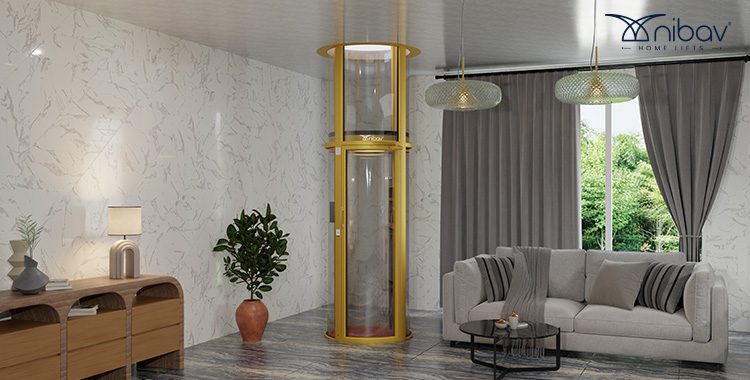Introduction
Let’s be real. Escalators are cool when you’re at the mall, holding a caramel latte and riding to the food court like royalty.
They’re flashy, fun, and make total sense in airports, train stations, and shopping centers where moving crowds fast is the name of the game.
But when it comes to your home? Yeah, no thanks.
Imagine one of those giant moving staircases wedged into your hallway—yikes. It’s loud, bulky, and about as subtle as a rollercoaster in your living room.
Now elevators? That’s a whole different story.
Especially the new-age home elevators designed with small spaces, smart tech, and beautiful interiors in mind. Whether you’re looking for comfort, accessibility, or just want to stop hauling laundry baskets and groceries up the stairs, they just make sense.
In this post, we’ll break down the real differences between elevators and escalators, their key features, where each works best, and why modern homes are fully embracing the elevator upgrade.
Let’s lift the lid (pun intended) on why home elevators for small spaces are becoming a must-have, not a maybe.
Quick Snapshot: Elevator vs Escalator
Let’s start with the basics—what’s what?
| Feature | Elevator | Escalator |
|---|---|---|
| Movement | Enclosed, compact cabin | Open staircase-style ramp |
| Common Use | Homes, offices, hospitals | Malls, airports, and subways |
| Space Needed | Minimal (customizable) | Large, open space |
| Ideal For Homes? | YES | No |
If you think about it, elevators are personal pods that carry you and your stuff vertically, all wrapped up in a cozy little box. Escalators, meanwhile, are more like moving stairways that are always in motion, perfect for crowds but not so much for your living room.
Elevators vs. Escalators: How They Work
Elevators
Think of a home elevator as a tiny private room that glides up and down between floors. These lifts don’t just save your knees—they save space, add convenience, and even boost home value. Today’s home elevators for small spaces are surprisingly compact—some models take up no more space than a standard linen closet.
They usually operate using one of these systems:
- Hydraulic lifts – Known for quiet, smooth rides and gentle stops
- Pneumatic vacuum elevators – Futuristic, tube-like systems using air pressure
- Traction or cable systems – Traditional elevator tech with a modern twist
Cool fact: Many small home elevator models now come with plug-in power, battery backups, and even smartphone control.
Some elevators can be installed with minimal structural change, making them perfect for retrofits or design-forward homes.
For instance, pneumatic vacuum elevators use air suction to lift the cabin and lower it gently using gravity. No need for a pit or machine room—just clear tubing, clean lines, and total wow-factor.
Why elevators win in homes:
- Minimal space requirements
- Works well in new builds and renovations
- Adds style, function, and long-term value
- Quiet and safe for all ages
Escalators
Escalators are like conveyor belts—but for people. They operate by rotating a continuous loop of steps using a chain-driven motor system. Great in malls and metro stations… a bit overkill for your two-story townhome.
Escalators shine in high-traffic commercial spaces where the goal is to move large groups of people without interruption. But all that constant motion comes with a few downsides: noise, space-hogging design, and frequent maintenance.
Why they’re not home-friendly:
- Require a lot of floor space and ceiling height
- Higher energy use and upkeep
- Not customizable for interiors
- Impossible to make look “cozy”
Escalators belong in shopping centers. Home elevators belong in, well… homes.
Feature Showdown: What Makes Each Tick?
Let’s break it down like you’re shopping for one (because hey, maybe you are).
Elevators
- Space-Savers: Designed to fit tight spots. Some need just a 36-inch opening.
- Safety Features: Door sensors, emergency stop buttons, backup power.
- Customizable Interiors: Wood panels? Glass walls? LED lighting? All of it.
- Energy Efficient: New models use less power than your fridge.
- Smart Controls: Some let you call the elevator from your phone or smartwatch.
Plus, many home elevators now come with smart safety features like automatic brakes and real-time diagnostics, meaning fewer surprise breakdowns. The latest designs even include voice commands—so you can say, “Elevator, take me up,” and it responds. It’s like living in the future.
Escalators
- Always Moving: No waiting—just hop on.
- High Capacity: Moves lots of people fast.
- Low Interaction: No buttons to press.
- Big Footprint: Needs tons of space, both horizontal and vertical.
Let’s be honest: Escalators are functional only in public buildings. Installing one at home would be… weird. Cool, maybe—for like five minutes. But weird.
They also require more energy to run continuously and need more maintenance since all those moving steps and motors wear out faster than a simple cable and pulley elevator system.
The Case for Home Elevators
Alright, here’s where things get juicy. Why are so many people adding home elevators to their upgrades list?
1. Aging in Place
You’re not getting younger (sorry, we all wish we were). Having a home elevator means:
- No stairs to climb as mobility changes
- Safe access to all floors
- Peace of mind for you or aging family members
2. Accessibility for Everyone
Not just for seniors. Think:
- Carrying groceries, luggage, or furniture? Done.
- Guests with mobility challenges? Covered.
- Temporary injury? No problem.
3. Adds Home Value
Real talk: A sleek, modern elevator? That’s a resale power move.
- Boosts property appeal
- Makes multi-level homes more marketable
- Adds a touch of luxury without overdoing it
4. Space-Efficient & Stylish
Today’s modern elevators aren’t bulky or ugly.
- Some are cylindrical and see-through
- Others blend right into your hallway wall
- You can even choose silent models—like, whisper quiet
Common Myths (Busted)
“Aren’t home elevators super expensive?”
Surprisingly? Not always. With compact models and more competition in the market, prices have dropped. You can install a basic residential elevator for less than a high-end kitchen reno.
“They must be huge!”
Old-school ones, maybe. But modern options can be tiny—taking up less space than a walk-in closet.
“Too complicated to install.”
Many new models don’t even need a pit or machine room. Translation: faster installs, less construction chaos.
Escalators: Still Cool, Just Not for Homes
To be fair, escalators rock where they belong:
- Shopping malls
- Airports
- Stadiums
- Transit hubs
They’re built for speed, volume, and durability. But trying to install one in your home would be like putting a treadmill in your bathroom. It can be done. But why?
So, What Should You Choose?
If you’re building a dream home, remodeling for better access, or just future-proofing your life, an elevator is the real MVP.
Here’s your decision checklist:
| Need | Best Choice |
|---|---|
| Multi-floor home convenience | Elevator |
| Accessibility for the aging or injured | Elevator |
| High-traffic commercial area | Escalator |
| Space-saving install | Elevator |
| Public transportation hub | Escalator |
Why Nibav?
When it comes to installing a home elevator, choosing the right brand matters just as much as choosing the right design. That’s where Nibav Home Elevators stand out. They specialize in home elevators for small spaces, combining cutting-edge tech with sleek aesthetics—all without turning your house into a construction zone.
Here’s why homeowners are choosing Nibav:
- Compact & Stylish: Nibav elevators are built to fit tight layouts without sacrificing design. Think premium feel in a minimal footprint.
- Plug & Play Installation: No major structural changes. No massive pits. No drama. Just quick, clean, hassle-free setup.
- Eco-Friendly Tech: Nibav’s elevators use air pressure systems that consume zero electricity during descent, helping you save on energy bills.
- Global Standards: Designed with international safety certifications and smart tech, including emergency brakes, backup systems, and voice controls.
- Custom Aesthetics: Available in multiple colors, finishes, and glass cabin styles—so your elevator looks like a feature, not an afterthought.
Whether you’re building your forever home or upgrading for aging-in-place comfort, Nibav delivers style, safety, and simplicity in every lift.
Final Thoughts
Escalators will always have their place in the hustle and bustle of public life. But for your home? Elevators are where function, style, and smart living collide.
Forget the noisy, industrial lift image—today’s home elevators are designed to enhance your lifestyle and your living space. They’re about more than just moving between floors—they’re about moving smarter.
Whether it’s carrying your sleepy toddler upstairs, helping elderly family members navigate safely, or simply avoiding the stairs after a brutal leg day, the benefits of a home elevator are too good to ignore.
They add comfort, convenience, and even long-term value to your property, making your home more accessible and future-ready.
So if you’re still picturing an elevator as some clunky metal box, it’s time for a reframe.
Because the modern home elevator is sleek, silent, space-savvy, and fits right into the heart of your home, both in function and in form.


